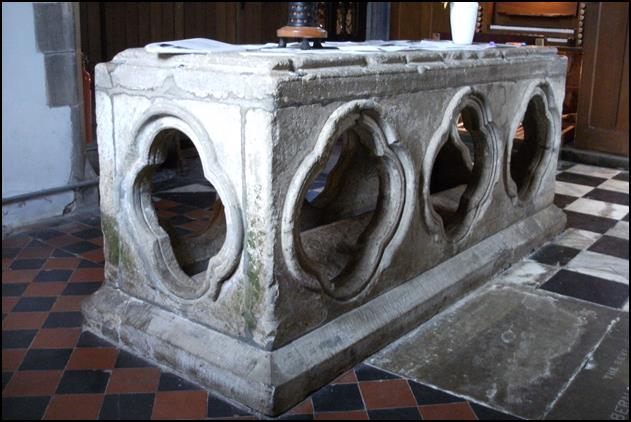Which religion starts with a husband and pregnant wife looking for shelter? And with an animal feeding trough? Tue 14 June 2022

Shrine of St Bertram, Holy Cross Church, Ilam, Staffordshire. Source: A Study of Post-Depositional Funerary Practices In Medieval England
From Cromwell and the Cathedral:
visiting an historic cathedral... there will usually, however, be a moment in the tour when the guide announces that some damage was done to the building during the English Civil War by Oliver Cromwell, often with the comment that he stabled his horses in the building.
And it wasn't only Cromwell.
From An Account of the Religious Houses Formerly Situated on the Eastern Side of the River Witham, Rev George Oliver, 1846, p91, footnote 24:
Guiot de Provens, who wrote in the 13th century, says of the Cistercians,
"the abbots and cellerars have ready money, eat large fish, drink good wine, and send to the refectory for those who do the work, the very worst. I have seen these monks," he continues, "build pigsties in churchyards, and make stables for asses in their chapels.
What are they talking about?
Infrastructure. Infrastructure like this:

The gravity-fed cattle trough. Source
Gravity-fed cattle troughs save farmers from having to replenish the trough before each feed.
Their individual feeding bays reduce competition between aggressive animals:
Fighting, fighting... And the waste! Source: 1,600sq ft cattle feeder
A closer look at the internals of the Shrine of St Bertram suggest it was designed to distribute feed evenly to animals feeding at both ends:

Hogback distribution wedge inside St Bertram's shrine, Holy Cross Church, Ilam. Source: A Study of Post-Depositional Funerary Practices In Medieval England
The hogback wedge distributed this feeding trough's contents toward the feeding holes in its sides. It suggests the contents were usually liquid or gel. Presumably blood, offal and meat were lactofermented in the now-missing chamber above and allowed to drip down.
Modern gravity feeders are made from metal rather than stone.
And also from plastic:

Gravity-fed pet food and drink dispenser. Source
And also from wood:

Gravity-fed pet food dispenser. Source
The principles remain the same but the differing properties of different construction materials change details in the designs.
The rebated upper edge of the Shrine of St Bertram hogback suggests its now-missing top half was a stone container - possibly a feed hopper.
Cemented cracks in its top slab show the tomb was damaged and then repaired at some time.
Originally, its top half probably looked more like this 'shrine' at Whitchurch, Dorset:

Shrine of St Wite at St Candida & Holy Cross Church, Whitchurch Canonicorum, Dorset. Source: A Study of Post-Depositional Funerary Practices In Medieval England
Both tombs have been repaired. When were they broken?
From Cromwell and the Cathedral:
About a third of our Cathedrals were deliberately damaged by Parliamentarian soldiers during the first 18 months of the Civil War (1642-1651). These were in Royalist towns which were captured by the Roundheads, with their stained glass smashed and marble tombs shattered as an expression of vengeance against a captured enemy town and of disapproval against iconoclastic church decorations.
Why did 'iconoclasts' break the marble 'tombs'?
From A Study of Post-Depositional Funerary Practices In Medieval England, p64:
‘a complete, but disarticulated, skeleton could be contained in quite a small container, as was St. Wita’s (Wite’s) at Whitchurch Canonicorum, but it was normally outwardly enshrined ... in such a way as to suggest a complete skeleton or body properly laid out’. The shrine to St Bertram in Holy Cross Church, Ilam (Staffordshire), is believed to contain the disarticulated bones of St Bertram or Bertelin
Who - or what - were they feeding?
From Ilam, Holy Cross Church - BritainExpress:
a shrine was established at his grave, and became a popular destination for pilgrims.
Pilgrims.
'Grims' equals 'devils' and 'demons'. Much more about what 'pilgrims' really means in Ice Age Sites of Britain's Serpents and subsequent pages.
Their pets were also fed:

Pet food advertisement at St Michael's, Temple Garway, Herefordshire.
We will see much more of this hungry creature in Away In A Manger - Part Two - Hogback Tombs.
It seems the church had begun to clean up its practices just before Civil War broke out.
From St John's Church, Corby Glen:
The wooden altar rails... were also added in the 17th century, part of controversial reforms introduced by Archbishop William Laud, the religious adviser to Charles I during the 1630s. In all churches, the altar had to be against the east wall and railed off to stop dogs getting in.
Too little, too late. Or so the Puritans said.
Feeding time poses risks to stock and farmers alike:
More ends up in the cow's belly. Source: Fence Line Feeder
And not just to stock and farmers. St Bertram's mythology - and the font at Holy Cross Church - hint at the danger for human travelers and the miracle survival of the baby born in the manger.
From Ilam, Holy Cross Church - BritainExpress:
The beautifully carved Norman font appears to illustrate episodes from the life of St Betram (sic). The first panel shows Betram and his wife newly married, while another panel shows his wife in labour.
Betram went in search of a midwife, but when he returned it was to discover that wild wolves had killed and eaten his wife and their newborn child.
Two more panels depict the wolves eating the mother and infant; these panels are very vivid and are not for the faint of heart!
You may recognise St Betram's story in some of its other guises. Especially in its major religious versions.
Shrine locations in this evidence collection.
© All rights reserved. The original author retains ownership and rights.
More of this investigation:
Away in a Manger,
More of this investigation:
Misunderstood Technology
More by tag:
#furniture, #medieval retail, #Manimal Farm, #human meat